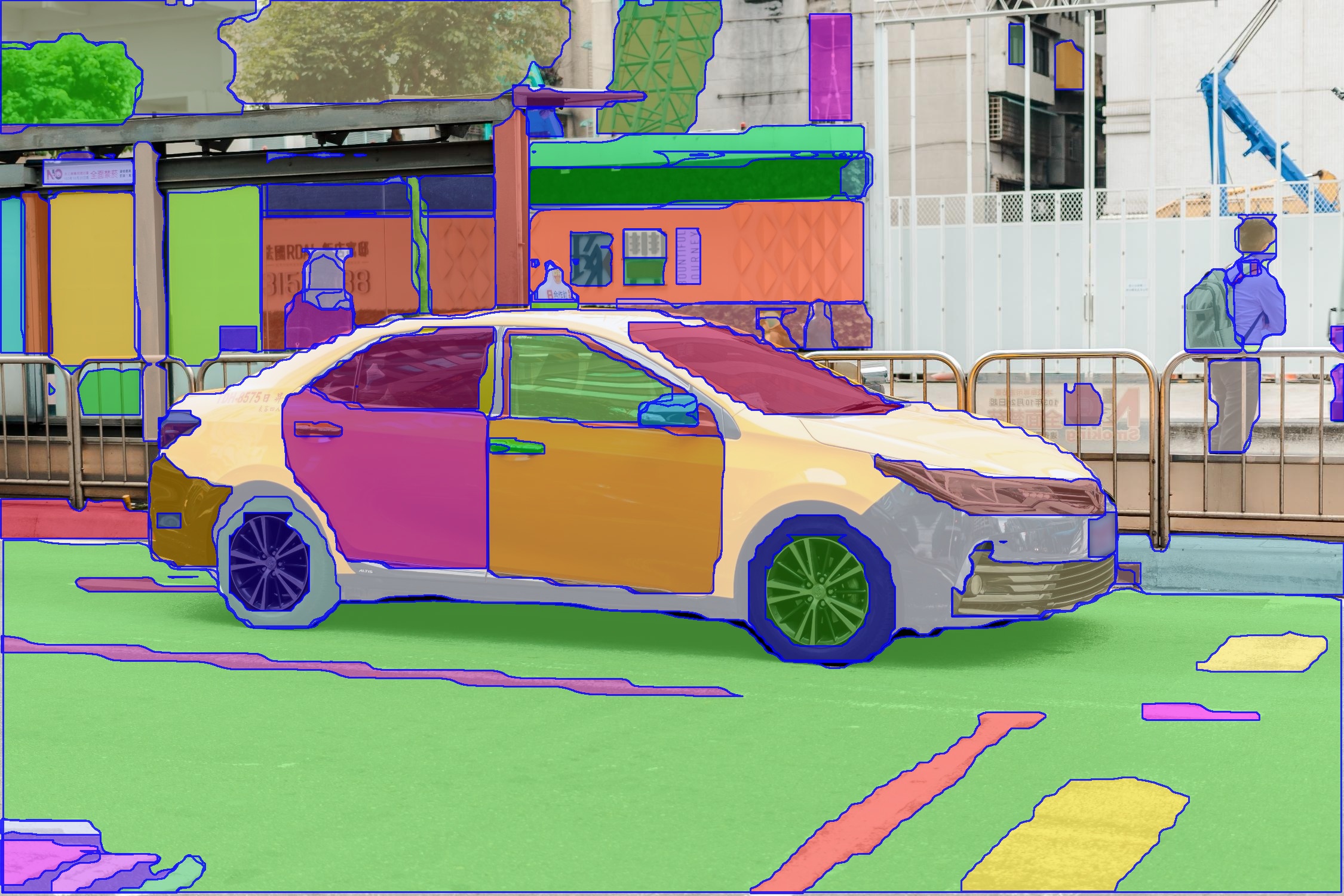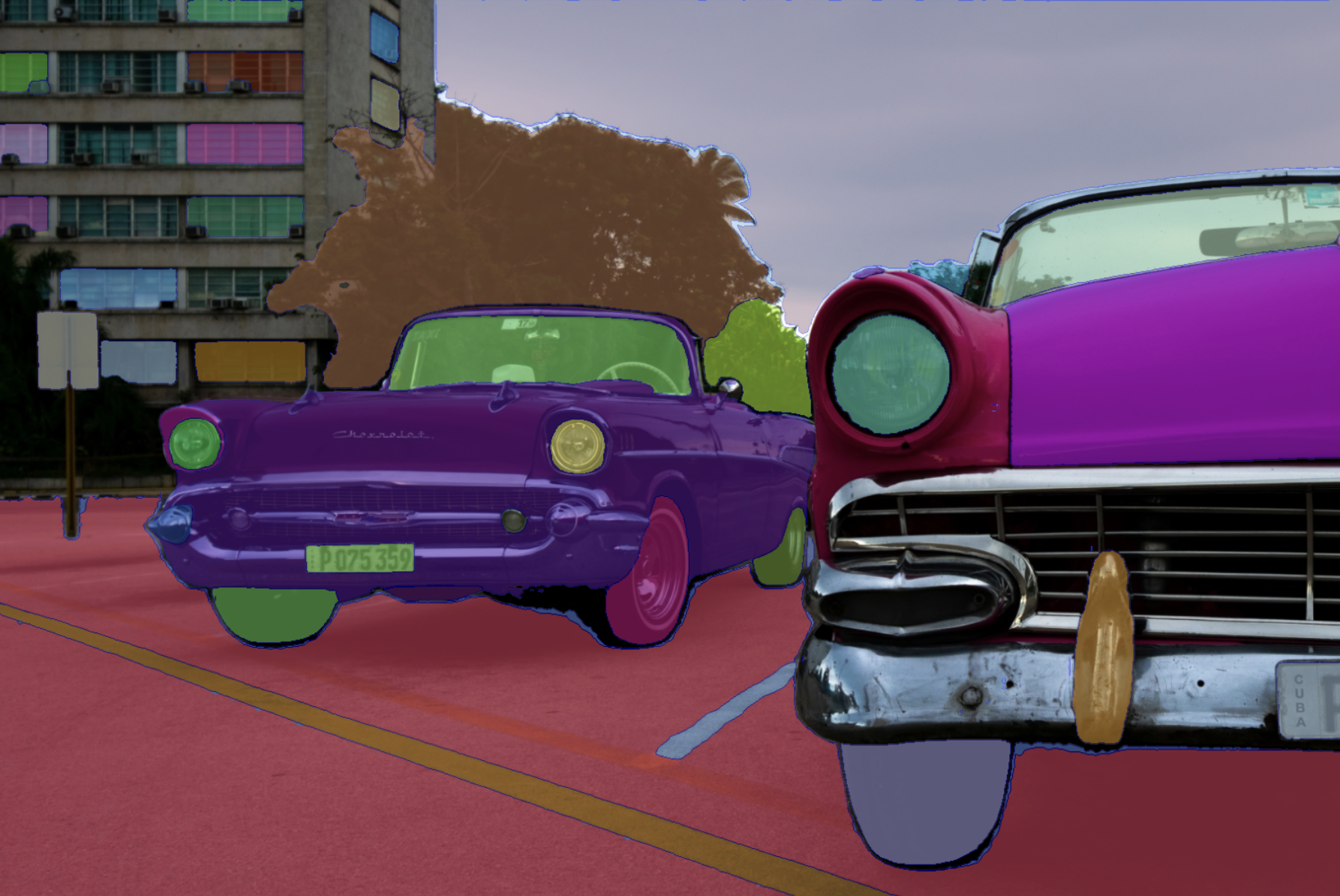sam-vit
Maintainer: peter65374

48

| Property | Value |
|---|---|
| Run this model | Run on Replicate |
| API spec | View on Replicate |
| Github link | View on Github |
| Paper link | View on Arxiv |
Create account to get full access
Model overview
The sam-vit model is a variation of the Segment Anything Model (SAM), a powerful AI model developed by Facebook research that can generate high-quality object masks from input prompts such as points or bounding boxes. The SAM model has been trained on a dataset of 11 million images and 1.1 billion masks, giving it strong zero-shot performance on a variety of segmentation tasks.
The sam-vit model specifically uses a Vision Transformer (ViT) as the image encoder, compared to other SAM variants like the sam-vit-base and sam-vit-huge models. This ViT-based encoder computes image embeddings using attention on patches of the image, with relative positional embedding used.
Similar models to sam-vit include the fastsam model, which aims to provide fast segment-anything capabilities, and the ram-grounded-sam model, which combines the SAM model with a strong image tagging model.
Model inputs and outputs
Inputs
- source_image: The input image file to generate segmentation masks for.
Outputs
- Output: The generated segmentation masks for the input image.
Capabilities
The sam-vit model can be used to generate high-quality segmentation masks for objects in an image, based on input prompts such as points or bounding boxes. This allows for precise object-level segmentation, going beyond traditional image segmentation approaches.
What can I use it for?
The sam-vit model can be used in a variety of applications that require accurate object-level segmentation, such as:
- Object detection and instance segmentation for computer vision tasks
- Automated image editing and content-aware image manipulation
- Robotic perception and scene understanding
- Medical image analysis and disease diagnosis
Things to try
One interesting aspect of the sam-vit model is its ability to perform "zero-shot" segmentation, where it can automatically generate masks for all objects in an image without any specific prompts. This can be a powerful tool for exploratory data analysis or generating segmentation masks at scale.
Another interesting direction to explore is combining the sam-vit model with other AI models, such as the ram-grounded-sam model, to leverage both the segmentation capabilities and the image understanding abilities of these models.
This summary was produced with help from an AI and may contain inaccuracies - check out the links to read the original source documents!
Related Models

fastsam

24
The fastsam model is a fast version of the Segment Anything Model (SAM), a powerful deep learning model for image segmentation. Unlike the original SAM, which uses a large ViT-H backbone, fastsam uses a more efficient YOLOv8x architecture, allowing it to achieve similar performance at 50x higher runtime speed. This makes it a great option for real-time or mobile applications that require fast and accurate object segmentation. The model was developed by the CASIA-IVA-Lab and is open-source, allowing developers to easily integrate it into their projects. The fastsam model is similar to other open-source AI models like segmind-vega, which also aims to provide a faster alternative to large, computationally expensive models. However, fastsam specifically targets the Segment Anything task, offering a unique and specialized solution. It's also similar to the original Segment Anything model, but with a much smaller and faster architecture. Model inputs and outputs Inputs input_image**: The input image for which the model will generate segmentation masks. text_prompt**: A text description of the object to be segmented, e.g., "a black dog". box_prompt**: The bounding box coordinates of the object to be segmented, in the format [x1, y1, x2, y2]. point_prompt**: The coordinates of one or more points on the object to be segmented, in the format [[x1, y1], [x2, y2]]. point_label**: The label for each point, where 0 indicates background and 1 indicates foreground. Outputs segmentation_masks**: The segmentation masks generated by the model for the input image, with one mask for each object detected. confidence_scores**: The confidence scores for each segmentation mask, indicating the model's certainty about the object detection. Capabilities The fastsam model is capable of generating high-quality segmentation masks for objects in images, even with minimal input prompts. It can handle a variety of object types and scenes, from simple objects like pets and vehicles to more complex scenes with multiple objects. The model's speed and efficiency make it well-suited for real-time applications and embedded systems, where the original SAM model may be too computationally expensive. What can I use it for? The fastsam model can be used in a wide range of computer vision applications that require fast and accurate object segmentation, such as: Autonomous driving**: Segmenting vehicles, pedestrians, and other obstacles in real-time for collision avoidance. Robotics and automation**: Enabling robots to perceive and interact with objects in their environment. Photo editing and content creation**: Allowing users to easily select and manipulate specific objects in images. Surveillance and security**: Detecting and tracking objects of interest in video streams. Things to try One interesting aspect of the fastsam model is its ability to perform well on a variety of zero-shot tasks, such as edge detection, object proposals, and instance segmentation. This suggests that the model has learned generalizable features that can be applied to a range of computer vision problems, beyond just the Segment Anything task it was trained on. Developers and researchers could experiment with using fastsam as a starting point for transfer learning, fine-tuning the model on specific datasets or tasks to further improve its performance. Additionally, the model's speed and efficiency make it a promising candidate for deployment on edge devices, where the real-time processing capabilities could be highly valuable.
Updated Invalid Date

sam-2

5
SAM 2: Segment Anything in Images and Videos is a foundation model for solving promptable visual segmentation in images and videos. It extends the original Segment Anything Model (SAM) by Meta to support video processing. The model design is a simple transformer architecture with streaming memory for real-time video processing. SAM 2 is trained on the Segment Anything Video (SA-V) dataset, the largest video segmentation dataset to date, providing strong performance across a wide range of tasks and visual domains. Model inputs and outputs The SAM 2 model takes an image or video as input and allows users to provide prompts (such as points, boxes, or text) to segment relevant objects. The outputs include a combined mask covering all segmented objects as well as individual masks for each object. Inputs Image**: The input image to perform segmentation on. Use M2M**: A boolean flag to use the model-in-the-loop data engine, which improves the model and data via user interaction. Points Per Side**: The number of points per side for mask generation. Pred Iou Thresh**: The predicted IoU threshold for mask prediction. Stability Score Thresh**: The stability score threshold for mask prediction. Outputs Combined Mask**: A single combined mask covering all segmented objects. Individual Masks**: An array of individual masks for each segmented object. Capabilities SAM 2 can be used for a variety of visual segmentation tasks, including interactive segmentation, automatic mask generation, and video segmentation and tracking. It builds upon the strong performance of the original SAM model, while adding the capability to process video data. What can I use it for? SAM 2 can be used for a wide range of applications that require precise object segmentation, such as content creation, video editing, autonomous driving, and robotic manipulation. The video processing capabilities make it particularly useful for applications that involve dynamic scenes, such as surveillance, sports analysis, and live event coverage. Things to try With SAM 2, you can experiment with different types of prompts (points, boxes, or text) to see how they affect the segmentation results. You can also try the automatic mask generation feature to quickly isolate objects of interest without manual input. Additionally, the video processing capabilities allow you to track objects across multiple frames, which could be useful for applications like motion analysis or object tracking.
Updated Invalid Date

sdxl-cat

1
The sdxl-cat is a human-like cat model developed by Peter65374 on Replicate. It is a variation of the SDXL text-to-image model, trained to generate images of cats with a human-like appearance. This model can be useful for creating whimsical or anthropomorphic cat images for various applications, such as illustrations, character designs, and social media content. Compared to similar models like sdxl-controlnet-lora, sdxl-outpainting-lora, and open-dalle-1.1-lora, the sdxl-cat model focuses specifically on generating human-like cat images, rather than more general text-to-image or image manipulation capabilities. Model inputs and outputs The sdxl-cat model accepts a variety of inputs, including a prompt, an optional input image, and various parameters to control the output, such as the image size, number of outputs, and more. The model then generates one or more images based on the provided inputs. Inputs Prompt**: The text prompt that describes the desired image. Image**: An optional input image to be used as a starting point for the image generation process. Width**: The desired width of the output image. Height**: The desired height of the output image. Num Outputs**: The number of images to generate. Guidance Scale**: A value that controls the balance between the input prompt and the image generation process. Num Inference Steps**: The number of steps to perform during the image generation process. Outputs Image(s)**: The generated image(s) based on the provided inputs. Capabilities The sdxl-cat model is capable of generating high-quality, human-like images of cats. The model can capture the nuanced features and expressions of cats, blending them with human-like attributes to create unique and whimsical cat characters. What can I use it for? The sdxl-cat model can be used for a variety of applications, such as: Creating illustrations and character designs for books, comics, or other media featuring anthropomorphic cats. Generating social media content, such as profile pictures or memes, with human-like cat characters. Experimenting with image manipulation and exploring the intersection of human and feline characteristics in art. Things to try One interesting thing to try with the sdxl-cat model is to experiment with different prompts that explore the human-like aspects of the cat characters. For example, you could try prompts that incorporate human emotions, activities, or clothing to see how the model blends these elements with the cat features. Another idea is to use the model in combination with other Replicate models, such as gfpgan, to enhance or refine the generated images further, improving the overall quality and realism.
Updated Invalid Date

segmind-vega

1
segmind-vega is an open-source AI model developed by cjwbw that is a distilled and accelerated version of Stable Diffusion, achieving a 100% speedup. It is similar to other AI models created by cjwbw, such as animagine-xl-3.1, tokenflow, and supir, as well as the cog-a1111-ui model created by brewwh. Model inputs and outputs segmind-vega is a text-to-image AI model that takes a text prompt as input and generates a corresponding image. The input prompt can include details about the desired content, style, and other characteristics of the generated image. The model also accepts a negative prompt, which specifies elements that should not be included in the output. Additionally, users can set a random seed value to control the stochastic nature of the generation process. Inputs Prompt**: The text prompt describing the desired image Negative Prompt**: Specifications for elements that should not be included in the output Seed**: A random seed value to control the stochastic generation process Outputs Output Image**: The generated image corresponding to the input prompt Capabilities segmind-vega is capable of generating a wide variety of photorealistic and imaginative images based on the provided text prompts. The model has been optimized for speed, allowing it to generate images more quickly than the original Stable Diffusion model. What can I use it for? With segmind-vega, you can create custom images for a variety of applications, such as social media content, marketing materials, product visualizations, and more. The model's speed and flexibility make it a useful tool for rapid prototyping and experimentation. You can also explore the model's capabilities by trying different prompts and comparing the results to those of similar models like animagine-xl-3.1 and tokenflow. Things to try One interesting aspect of segmind-vega is its ability to generate images with consistent styles and characteristics across multiple prompts. By experimenting with different prompts and studying the model's outputs, you can gain insights into how it understands and represents visual concepts. This can be useful for a variety of applications, such as the development of novel AI-powered creative tools or the exploration of the relationships between language and visual perception.
Updated Invalid Date